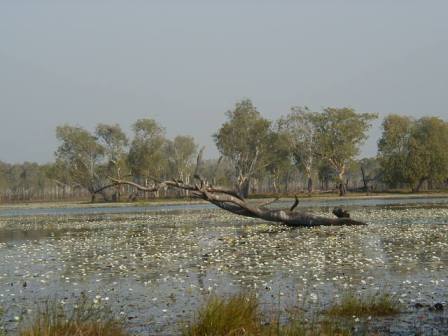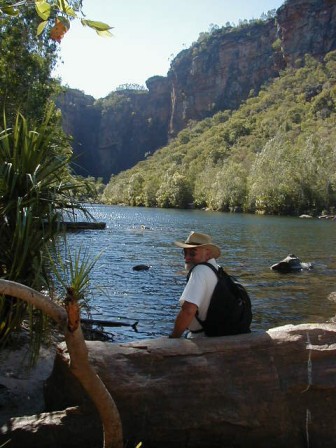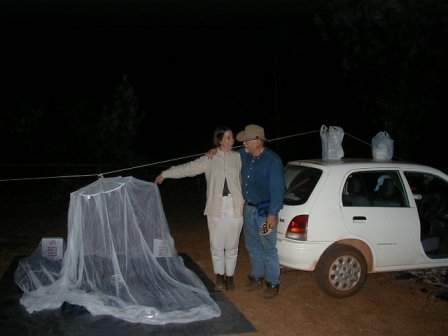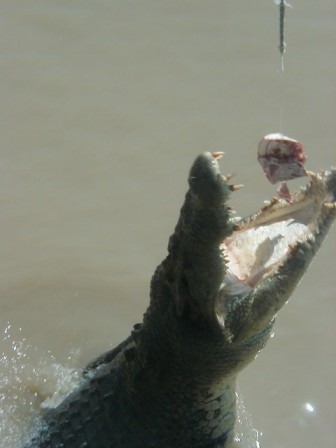Katherine to Darwin
Kakadu or
Kakadon't ....... During our stay in Katherine, the
word from the "grey nomads", or as we are now calling them,
"geriatric gypsies" was Kakadon't, but we were going anyway to judge
for ourselves. We travelled to Pine Creek and then
entered the south end of the National Park along the Kakadu Highway. At the Southern
Entry and Ranger Station you pay $15.00 per person for a 14 day stay. From here
you can elect to stay in caravan parks at around $22-25 per night or bush camp
with showers and toilets for $10 per night. You definitely need a
4WD to see some of the most spectacular attractions. This leads to my 3rd
rule of outback travel and may explain why the "geriatric gypsies"
don't like Kakadu. Rule
No. 3 of Outback Touring. The best tourist attractions are either a
long walk from a car park and/or a 4WD trek.
 The
park covers almost 20,000 square kilometres and includes traditional lands of a
number of Aboriginal clan groups and these areas can only be visited if you
have obtained a permit. For at least 50,000 years, Aboriginal people have
continuously lived in the area. It was shaped by the spiritual
ancestors of aboriginal people during the Creation Time. These ancestors or
"first people" journeyed across the country creating landforms,
plants, animals and aboriginal people. With them, they brought laws to
live by including ceremony, language, kinship and ecological knowledge, and
they taught aboriginal people how to live with the land and look after the
country.
The
park covers almost 20,000 square kilometres and includes traditional lands of a
number of Aboriginal clan groups and these areas can only be visited if you
have obtained a permit. For at least 50,000 years, Aboriginal people have
continuously lived in the area. It was shaped by the spiritual
ancestors of aboriginal people during the Creation Time. These ancestors or
"first people" journeyed across the country creating landforms,
plants, animals and aboriginal people. With them, they brought laws to
live by including ceremony, language, kinship and ecological knowledge, and
they taught aboriginal people how to live with the land and look after the
country.
Our first day was to set up our bush camp site at Mardugal and at sunset
went to the Yellow Water Wetlands to see the wildlife. Yellow Waters is
part of the South
Alligator River
floodplain and during the dry season you are able to walk along the boardwalk
of the Home Billabong and view the wildlife. There are something like 240
different species of birds that gather in Kakadu.
 We
moved on the next day to another bush camp site called Muirella Park.
These bush camp sites are very popular and well maintained, better than the
over expensive caravan park. The greatest highlight of all was our trip
to Jim Jim
Falls and Twin Falls by 4WD. The road is 70kms
with the first 45km badly corrugated and dusty with the last 25 km mostly of
deep sand, washouts, and bulldust. Jim Jim Falls were not flowing but a 1km return
walk over boulders brings you to the plunge pool, 150 metres below the
falls. The only way to see these falls in full fall is by scenic flight
during the wet season. There is a lovely sandy beach next to the falls
and spectacular escarpments on three sides.
We
moved on the next day to another bush camp site called Muirella Park.
These bush camp sites are very popular and well maintained, better than the
over expensive caravan park. The greatest highlight of all was our trip
to Jim Jim
Falls and Twin Falls by 4WD. The road is 70kms
with the first 45km badly corrugated and dusty with the last 25 km mostly of
deep sand, washouts, and bulldust. Jim Jim Falls were not flowing but a 1km return
walk over boulders brings you to the plunge pool, 150 metres below the
falls. The only way to see these falls in full fall is by scenic flight
during the wet season. There is a lovely sandy beach next to the falls
and spectacular escarpments on three sides.
From there it was another 12 kms to reach Twin Falls. The drive took us through a
1 metre deep river crossing. The only way to reach the falls is by
way of a walk of 500 metres to the river and then a 500 metre swim up the
river. A crocodile net is placed across the river in the dry season to
catch any wandering crocodiles but the main concern for Liz was the 500
metre swim. We both managed to make the distance with the occasional stop
to rest on a big boulder protruding from the water. At the other end it
really was worth all the effort. These falls were dropping a lot of water
down into this plunge pool, from approximately 100 metres up the
escarpment. The water again was crystal clear with a beautiful clean
sandy beach to lie on after your swim. Our return swim was a little
easier as we were swimming with the current. Definitely a must for anyone
thinking of visiting Kakadu.
 At
the Muirella Park
bush camp site we met up with a couple of crazy Americans, Rebecca and Chuck
from Washington DC. Their idea of camping left a lot
to be desired and was what we call, undercamping. A ground sheet, one
double mosquito net tied to the rental car, the other end tied to a tree and
held down with two 10 litre containers of water, two cheap air mattresses and a
sleeping bag each. We enjoyed their company and they slept soundly
even with the dingoes howling during the night.
At
the Muirella Park
bush camp site we met up with a couple of crazy Americans, Rebecca and Chuck
from Washington DC. Their idea of camping left a lot
to be desired and was what we call, undercamping. A ground sheet, one
double mosquito net tied to the rental car, the other end tied to a tree and
held down with two 10 litre containers of water, two cheap air mattresses and a
sleeping bag each. We enjoyed their company and they slept soundly
even with the dingoes howling during the night.
Nourlangie Rock was our next visit. This is a 1.5 walk which
takes you past an ancient Aboriginal shelter and several art sites which are
over 2,000 years old. Our exercise continued with a steep climb to
Gunwarddehwardde lookout and some fantastic views of Kakadu and Arnhem Land. We didn't stop there, it was then time
for lunch at Anbangbang Billabong and a 2.5 km walk for more bird
watching. We could become experts at bird watching (the feathered kind)
before the trip is over. The colours and types of birds around are really
interesting. Did you know there is a blue winged kookaburra that has a
different noise than the ordinary kookaburra, and the rainbow colours of the
rainbow bee eater are truly beautiful.
We drove to Jabiru and stayed at the Frontier Village
Caravan Park,
over expensive and over rated. Jabiru is quite a big town with a
supermarket, banking facilities and a few shops. There is a school, a
fair amount of housing and recreational facilities. One night here and we
were itching to get back to our bush camping. We made our way up to Ubirr
and the border of Arnhem Land. Our home
for the night was Merl bush camp and here we were surrounded by Germans.
We have come in contact with so many who all love to visit the Top End during
their summer vacation.
 Ubirr
has some fascinating Aboriginal Rock art sites especially in an area of rock
called the Main Gallery. Another climb to the lookout gave some
superb views over the Nardab floodplain. We went on our own crocodile
hunting expedition at Bardedjilidji, a walk if 2.5 kms through some layered
sandstone escarpments and then we followed the track along the East Alligator
River, where we saw two
crocodiles. Rob wanted to take some photos but they disappeared under the
water and Liz wanted to move on very quickly.
Ubirr
has some fascinating Aboriginal Rock art sites especially in an area of rock
called the Main Gallery. Another climb to the lookout gave some
superb views over the Nardab floodplain. We went on our own crocodile
hunting expedition at Bardedjilidji, a walk if 2.5 kms through some layered
sandstone escarpments and then we followed the track along the East Alligator
River, where we saw two
crocodiles. Rob wanted to take some photos but they disappeared under the
water and Liz wanted to move on very quickly.
It was time to move on towards Darwin
and have a rest from the red earth and tread on green grass for a change.
We stayed at the Bark Hut Inn on the Arnhem Highway and drove out to the Mary
River Wetlands via Point Stuart
Road, a 4x4 road to view again the wildlife.
The giant pink waterlilies lined the banks of the river and there were numerous
salt water crocodiles here. Definitely no swimming.
Dem Crocs, Dem Sure Have
Big Mouths, Eat You All Up Man!!!!!...... Next day  we
travelled to the Adelaide
River and took an
organized boat cruise to see the Jumping Crocodiles, and boy are they big and
do they jump high. There are quite a number, one is 100 years old and
called Hannibal.
He was on the bank and at least 6 metres in length. The crocodiles just
appear from off the bank and swim out to the boat to be fed. One of 60
years of age came off the bank and out to the boat. A large piece of meat
was then dangled just above the water level and this huge beast leapt out of
the water a couple of times and eventually grabbed the meat in its mouth.
There were others not quite that big doing the same thing. It really was
worth seeing. The crocodiles have learnt that the boat brings food.
This popular tour has been running ten years and was well worth doing.
we
travelled to the Adelaide
River and took an
organized boat cruise to see the Jumping Crocodiles, and boy are they big and
do they jump high. There are quite a number, one is 100 years old and
called Hannibal.
He was on the bank and at least 6 metres in length. The crocodiles just
appear from off the bank and swim out to the boat to be fed. One of 60
years of age came off the bank and out to the boat. A large piece of meat
was then dangled just above the water level and this huge beast leapt out of
the water a couple of times and eventually grabbed the meat in its mouth.
There were others not quite that big doing the same thing. It really was
worth seeing. The crocodiles have learnt that the boat brings food.
This popular tour has been running ten years and was well worth doing.
It was then onto Darwin
straight up the Stuart Highway.
Sunny Darwin......
The lifestyle in Darwin
is very casual and a relaxed style of tropical living. There is no hustle
and bustle of city life mainly because of the weather. Every day has been
very warm with balmy warm nights. You couldn't rush if you tried.
Even though Cyclone Tracy destroyed the entire city and a number of the older
buildings, some of these have been reconstructed to represent the
architecture of the era.
A good insight into what the people of Darwin
experienced with Cyclone Tracy in 1974, is a visit to the Museum and Art Gallery
of the Northern Territory.
Here you could sit and watch some actual footage of the havoc Cyclone Tracy
caused. There was also an impressive display of Aboriginal art and the
difference in each artist's work.
Territorians are very keen on their night markets. Certain suburbs
around Darwin
have their own markets, mainly Thursday, Friday, Saturday and Sunday. The
most popular by far is the Mindil Beach Market. This market is held each
Thursday and Sunday from 5.00 pm during the dry season and people from
everywhere come to sample the cooked food from over twenty different countries.
It's set amongst shady trees with a spectacular sunset. As well as food stalls
there are a large number of craft stalls and the whole night has a carnival
atmosphere about it, with buskers performing during the night. This
brings me to.... Rule No.
4 of Outback Touring. Mosquitoes will find the one square inch of
exposed skin on which you haven't sprayed Aeroguard.
Another good night is the Sunday Sunset Jazz Nite held at Cullen Bay
on the lawns overlooking the boat harbour. People start gathering from
4.30 pm and bring their rugs and chairs and their bottle of wine and the cold
beer. It was very pleasant lying on our rug with a nice cold beer
listening to the band.
It is definitely a city where you live outdoors more than indoors and during
the dry season you can plan a barbeque weeks ahead and know that it will not be
raining or cold. That's all very good, but the build up to the wet
season, and the wet season must be very testing.
 Aquascene
Fish Feeding at Doctors Gully was fun. Every day at high tide hundreds of
fish come in from the sea to be fed. Mullet, milkfish, bream, catfish,
sting rays swim all around you in the water, even in between your legs whilst
you feed them by hand. You can actually pat their slimy skin. Some
are nearly a metre in length (fair dinkum, oops I mean - true.)
Aquascene
Fish Feeding at Doctors Gully was fun. Every day at high tide hundreds of
fish come in from the sea to be fed. Mullet, milkfish, bream, catfish,
sting rays swim all around you in the water, even in between your legs whilst
you feed them by hand. You can actually pat their slimy skin. Some
are nearly a metre in length (fair dinkum, oops I mean - true.)
Where we are staying there is a beautiful pool which we have made the most
of, mainly due to the warm weather. There is no difficulty in diving in
at least three times a day. Another nice swimming spot is the Berry
Springs. The water flows over this small waterfall and into the pool
below where all different types of fish swim about. The water, coming
from an underground spring about 10 metres away is beautiful, just the right
temperature, so we spent a few hours there enjoying the natural surrounds.
There is plenty to do in and around Darwin
but as we have been here 10 days, we have itchy feet to visit Litchfield National Park
and spend some time exploring the area so Sunday (August 29) we depart and
start our journey south.
This
page last updated on August 28, 1999. No more updates to this page.
 The
park covers almost 20,000 square kilometres and includes traditional lands of a
number of Aboriginal clan groups and these areas can only be visited if you
have obtained a permit. For at least 50,000 years, Aboriginal people have
continuously lived in the area. It was shaped by the spiritual
ancestors of aboriginal people during the Creation Time. These ancestors or
"first people" journeyed across the country creating landforms,
plants, animals and aboriginal people. With them, they brought laws to
live by including ceremony, language, kinship and ecological knowledge, and
they taught aboriginal people how to live with the land and look after the
country.
The
park covers almost 20,000 square kilometres and includes traditional lands of a
number of Aboriginal clan groups and these areas can only be visited if you
have obtained a permit. For at least 50,000 years, Aboriginal people have
continuously lived in the area. It was shaped by the spiritual
ancestors of aboriginal people during the Creation Time. These ancestors or
"first people" journeyed across the country creating landforms,
plants, animals and aboriginal people. With them, they brought laws to
live by including ceremony, language, kinship and ecological knowledge, and
they taught aboriginal people how to live with the land and look after the
country.  We
moved on the next day to another bush camp site called
We
moved on the next day to another bush camp site called  At
the
At
the  Ubirr
has some fascinating Aboriginal Rock art sites especially in an area of rock
called the Main Gallery. Another climb to the lookout gave some
superb views over the Nardab floodplain. We went on our own crocodile
hunting expedition at Bardedjilidji, a walk if 2.5 kms through some layered
sandstone escarpments and then we followed the track along the
Ubirr
has some fascinating Aboriginal Rock art sites especially in an area of rock
called the Main Gallery. Another climb to the lookout gave some
superb views over the Nardab floodplain. We went on our own crocodile
hunting expedition at Bardedjilidji, a walk if 2.5 kms through some layered
sandstone escarpments and then we followed the track along the  we
travelled to the
we
travelled to the  Aquascene
Fish Feeding at Doctors Gully was fun. Every day at high tide hundreds of
fish come in from the sea to be fed. Mullet, milkfish, bream, catfish,
sting rays swim all around you in the water, even in between your legs whilst
you feed them by hand. You can actually pat their slimy skin. Some
are nearly a metre in length (fair dinkum, oops I mean - true.)
Aquascene
Fish Feeding at Doctors Gully was fun. Every day at high tide hundreds of
fish come in from the sea to be fed. Mullet, milkfish, bream, catfish,
sting rays swim all around you in the water, even in between your legs whilst
you feed them by hand. You can actually pat their slimy skin. Some
are nearly a metre in length (fair dinkum, oops I mean - true.)